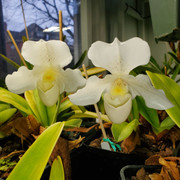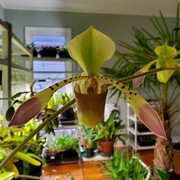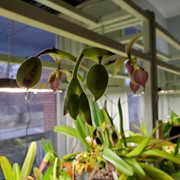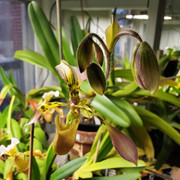tnyr5
Well-Known Member
Eh... If it isn't anything special, why not enjoy it just for being an example of the species that will grow for you and keep its pollen on its anthers lol.

I hear you. My thought is that it is worth breeding on simply because the plant grows well and is an example of the true species.Eh... If it isn't anything special, why not enjoy it just for being an example of the species that will grow for you and keep its pollen on its anthers lol.
And I love it for itself. Not enough to pay a bazillion dollars and wait 15 years for the big show. But glad and grateful that you are stewarding it. Sneaky hybrids are the devil.I hear you. My thought is that it is worth breeding on simply because the plant grows well and is an example of the true species.
I suspect many of the plants sold as sanderianum today are actually Michael Koopowitz backcrosses.
One could also argue that line breeding for better flower quality is always more valuable, but in my view there is no point in breeding towards an enhanced sanderianum.
Unlike roths, where line breeding is toward a clear aesthetic goal, sanderianum is never going to be the most aesthetically pleasing orchid. Sure the long petals are cool, but in my opinion sanderianum in its pure essence is quite an ugly flower.
Speak for yourself! I want 5-foot petals! LolI hear you. My thought is that it is worth breeding on simply because the plant grows well and is an example of the true species.
I suspect many of the plants sold as sanderianum today are actually Michael Koopowitz backcrosses.
One could also argue that line breeding for better flower quality is always more valuable, but in my view there is no point in breeding towards an enhanced sanderianum.
Unlike roths, where line breeding is toward a clear aesthetic goal, sanderianum is never going to be the most aesthetically pleasing orchid. Sure the long petals are cool, but in my opinion sanderianum in its pure essence is quite an ugly flower.
Ray, is it possible to run Kelpak (at proper dilution) through a mister?Annica, Kelpak is produced in South Africa and is certainly available in Europe.
Do not be tempted to get another kelp extract, as they are very dissimilar in the efficacy. Kelpak has been used globally for over 40 years on food-, and fruit crops, nuts, grains, turf and landscaping plants. I “discovered” it a bit over a decade ago and brought it to the orchid world.











Certainly, but I think that would be wasteful.Ray, is it possible to run Kelpak (at proper dilution) through a mister?
Thanks, it was worth a try.Certainly, but I think that would be wasteful.
The guy that used to be the US distributor owned a winery. When the vines started to bud up, he would spray the vines, leading to rachis elongation, allowing better grape growth and easier penetration of fungicides.
However, generally speaking, orchids are not particularly good at foliar uptake, thanks to the waxy cuticle layers on their leaves - an adaptation intended to slow water loss, it also slows uptake. I’m not saying that would be ineffective, just less so than for a terrestrial plant, plus…mature phals and catts seem to have thick cutices, while young plants and thin-leaved species don’t, so should absorb it better.
P. primulinum is another one, a big batch of Pinocchio flasks was sold as primulinum 20+ years ago and now all the big, impressive line bred prims are likely hybrids.That might be the case with sanderianum. I read last year that spicerianum is also like that. I don`t remember if it was spicerianums before 2008 or 2002, but if the mother plants are before that time, it should be safe to say they are the true species. If they are grown from mother plants after 2008 (?) they probably are not the real species.
Also with Hardy Orchids, in Europe, most of the plants that are sold as Dactylorhiza foliosa are actually D. Foliorella (foliosa x purpurella).




Spots on dorsal of haynaldianum.How does one distinguish haynaldianum from lowii?
That are likely controlled by a handful of genes out of the 20,000+Spots on dorsal of haynaldianum.